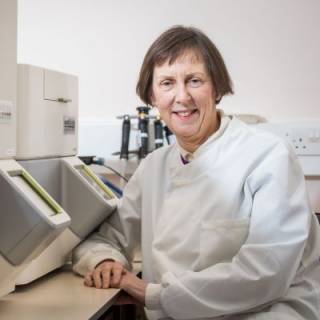A deeper understanding of the genetics of bone cancers - the work of Professor Adrienne Flanagan and colleagues - is providing clinicians with greater diagnostic confidence and opening up new therapeutic opportunities.
There are multiple forms of primary bone tumours, both benign and malignant, which can be hard to distinguish down the microscope - with significant implications for treatment. However, over the past decade, the genetic profiles of the majority of bone tumours have been described, enabling pathologists to provide more sound diagnoses on which clinicians can base their treatments. Furthermore, genetic dissection of these tumours is providing new insights into their underlying biology - with implications for diagnosis, prognosis and therapy development.
Back in 2006, Professor Flanagan and colleagues found that persistent expression of the brachyury gene (T) was highly characteristic of chordoma, a rare cancer thought to derive from the notochord - an embryonic structure not seen in post-fetal life [1]. More recently, gene sequencing of multiple tumour types, in collaboration with the Wellcome Trust Sanger Institute and the Crick Institute, has provided unprecedented insight into the genetic aberrations driving a range of bone cancers.
Genetic characterisation can have diagnostic value. The specificity of histone mutations, for example, can help to distinguish two closely related conditions, chondroblastoma and giant cell tumour of bone [2]. In other cases, the genetic findings hint at the possibility of repurposing of targeted chemotherapeutic agents. For example, IGF1R mutations and gene amplifications were identified in 21% of cases of osteosarcoma [3], and PI3K mutations in 16% of sporadic chordomas [4], two targets for which drugs already exist.
No drug treatments are available yet for chordoma. However, a screening of more than 1000 compounds led by Professor Flanagan found that several of the most active were EGFR inhibitors, suggesting a promising pathway for drug targeting [5]. This and other research has led to a clinical trial of an EGFR inhibitor for patients with chordoma.
Professor Flanagan has also been examining the role of epigenetics in the persistence of brachyury expression in chordoma. A screen of multiple compounds affecting the enzymatic machinery responsible for epigenetic modification of DNA has identified several that influence brachyury expression and the survival of chordoma cell lines - opening up exciting avenues for drug development.
Genetic analyses can also have prognostic significance - FGFR1 gene amplification, for example, was found to be responsible for poor response to chemotherapy in osteosarcoma [6]. However, inhibitors are available that might benefit patients with a tumour harbouring this genetic alteration. Professor Flanagan and colleagues have also been exploring the potential of circulating tumour DNA as a prognostic biomarker for bone cancers such as chondrosarcoma [7]. Pilot studies found that the presence of circulating tumour DNA correlated with tumour grade and was associated with poor outcomes, and levels were reduced following treatment. A nationwide study is now underway to assess the clinical utility of circulating tumour DNA measurement in chondrosarcoma.
Professor Flanagan has also led the development of UCL Advanced Diagnostics, which provides a high-quality genetic diagnostic service for University College London Hospital and other clinical centres. UCL Advanced Diagnostics has now been spun out of UCL and is managed by Health Services Laboratories, but will maintain close links with Professor Flanagan's and other UCL laboratories to ensure that advances in the genetic understanding of cancer rapidly feed into the diagnostic services available within the health service.
- Vujovic S et al. Brachyury, a crucial regulator of notochordal development, is a novel biomarker for chordomas. J Pathol. 2006;209(2):157-65.
- Behjati S et al. Distinct H3F3A and H3F3B driver mutations define chondroblastoma and giant cell tumor of bone. Nat Genet. 2013;45(12):1479-82.
- Behjati S et al. Recurrent mutation of IGF signalling genes and distinct patterns of genomic rearrangement in osteosarcoma. Nat Commun. 2017;8:15936.
- Tarpey PS et al. The driver landscape of sporadic chordoma. Nat Commun. 2017;8(1):890.
- Scheipl S et al. EGFR inhibitors identified as a potential treatment for chordoma in a focused compound screen. J Pathol. 2016;239(3):320-34.
- Fernanda Amary M et al. Fibroblastic growth factor receptor 1 amplification in osteosarcoma is associated with poor response to neo-adjuvant chemotherapy. Cancer Med. 2014;3(4):980-7.
- Gutteridge A et al. Digital PCR analysis of circulating tumor DNA: a biomarker for chondrosarcoma diagnosis, prognostication, and residual disease detection. Cancer Med. 2017;6(10):2194-2202.
 Close
Close


